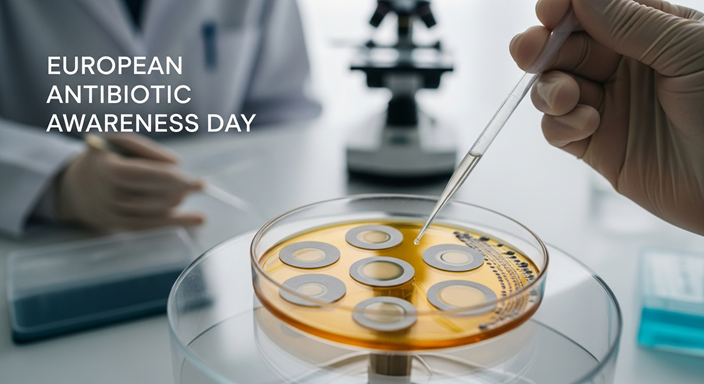#Antibiotics have saved millions of #lives, yet the #world is now at #risk because of their #misuse. European Antibiotic Awareness Day (#EuropeanAntibioticAwarenessDay) serves as an essential reminder that antibiotic resistance is one of the most serious #health challenges of our time. This day inspires #countries, #healthcare providers, and #citizens to act #responsibly and preserve the effectiveness of these life-saving medicines. In an era when #global health is constantly #evolving, this annual observance encourages #awareness, responsible #antibiotic use, and unified efforts to prevent #drug-resistant #infections. It brings together all sectors — #medical, #social, and #governmental — to protect #future generations.
History of European Antibiotic Awareness Day
European Antibiotic Awareness Day (EAAD) was first established in 2008 by the European Centre for Disease Prevention and Control (ECDC). The growing concern regarding antimicrobial resistance (AMR) in the early 2000s prompted European health leaders to create a platform that would raise awareness about the responsible use of antibiotics.
The initiative was born out of increasing scientific evidence that misuse and overprescription of antibiotics were leading to bacterial strains that existing medicines could no longer treat. The ECDC recognized the urgency and brought together EU member states, healthcare professionals, researchers, and policymakers to create an annual event that would spark conversation, education, and preventive action.
Over the years, EAAD has turned into a major health movement. It has inspired countries not only within Europe but also beyond to join the fight against antibiotic resistance. Today, it is a key component of the global campaign against AMR.
Importance of European Antibiotic Awareness Day
European Antibiotic Awareness Day holds immense importance because it addresses a growing public health threat—antibiotic resistance. Without action, infections that were once easy to treat could become untreatable.
This day is important because:
-
It educates the public about the dangers of unnecessary antibiotic use.
-
It guides healthcare professionals to prescribe antibiotics responsibly.
-
It promotes research and innovation for the development of new antibiotics.
-
It strengthens national and international policy actions that regulate antibiotic use.
-
It encourages collaborative solutions by recognizing that AMR is a global problem.
Antibiotics are a limited resource. EAAD helps ensure their effectiveness for future generations.
When European Antibiotic Awareness Day Is Celebrated and Why the Date Was Chosen
European Antibiotic Awareness Day is observed every year on 18 November.
The date was chosen to align with the global focus on antimicrobial resistance during the latter part of the year and to coordinate with the World Antimicrobial Awareness Week. A fixed date ensures consistency and allows for effective planning of events throughout Europe.
Significance of European Antibiotic Awareness Day
The significance of EAAD lies in its ability to unite people across Europe in the fight against antibiotic resistance. It promotes the responsible use of antibiotics, supports scientific research, and encourages policymakers to take meaningful action.
Some of its key contributions include:
-
Promoting knowledge about antibiotic misuse.
-
Encouraging evidence-based prescribing practices.
-
Empowering citizens to use antibiotics responsibly.
-
Strengthening international cooperation in combating AMR.
Why European Antibiotic Awareness Day Is Celebrated
This day is celebrated to:
-
Raise awareness about antibiotic misuse.
-
Highlight the rising threat of antibiotic-resistant bacteria.
-
Promote responsible use of antibiotics among individuals and medical professionals.
-
Support global campaigns against antimicrobial resistance.
-
Encourage governments and organizations to take concrete actions.
Ultimately, it aims to protect the effectiveness of antibiotics for future generations.
How European Antibiotic Awareness Day Is Celebrated
1. Awareness Campaigns
Public health bodies launch educational campaigns online and in communities.
2. Workshops & Seminars
Medical institutions offer training sessions and updated guidelines for healthcare professionals.
3. Scientific Discussions & Conferences
Experts come together to share research and discuss antimicrobial resistance trends.
4. School Programs
Students learn about hygiene, infection prevention, and the importance of using medicines correctly.
5. Community Outreach
Health centers conduct free counseling sessions.
6. Government Initiatives
Public health agencies announce new measures or release national AMR situation reports.
7. Social Media Engagement
Hashtags like #EAAD spread the message widely.
Countries Where European Antibiotic Awareness Day Is Celebrated
EAAD is celebrated primarily in all European Union and European Economic Area (EEA) member countries, including:
Germany, France, Italy, Spain, Portugal, Sweden, Finland, Denmark, Netherlands, Belgium, Poland, Austria, Greece, Ireland, Lithuania, Latvia, Estonia, Czech Republic, Slovakia, Hungary, Romania, Bulgaria, Slovenia, Croatia, Luxembourg, Malta, Cyprus.
Several neighboring regions also participate through awareness collaborations.
How Citizens Involve Themselves and Make It a Success
-
Learning and sharing accurate information with family and community.
-
Avoiding self-medication and using antibiotics only when prescribed.
-
Completing full antibiotic courses.
-
Maintaining good hygiene practices.
-
Participating in awareness events or health sessions.
-
Supporting the correct use of antibiotics in pets and livestock.
-
Following medical advice and not demanding antibiotics unnecessarily.
These actions collectively make EAAD impactful and effective.
Theme for European Antibiotic Awareness Day 2025
“Strengthening Stewardship: Use Antibiotics Wisely Today to Protect Tomorrow.”
10 Famous Quotes for European Antibiotic Awareness Day
-
“Antibiotics are a precious resource—use them wisely.”
-
“The misuse of antibiotics today is the resistance of tomorrow.”
-
“Fighting antibiotic resistance begins with informed choices.”
-
“When antibiotics fail, simple infections become deadly.”
-
“Your health decisions can protect the world from resistance.”
-
“Responsible antibiotic use saves lives.”
-
“Antibiotics are not always the answer—ask before you take.”
-
“Together, we can stop the rise of superbugs.”
-
“Preserve antibiotics—our survival depends on it.”
-
“Awareness today ensures protection tomorrow.”
FAQs
1. What is European Antibiotic Awareness Day?
An annual observance promoting responsible antibiotic use and raising awareness about antibiotic resistance.
2. When is European Antibiotic Awareness Day celebrated?
On 18 November every year.
3. Who started the day?
The European Centre for Disease Prevention and Control (ECDC) initiated it in 2008.
4. What is the main purpose of EAAD?
To reduce antibiotic misuse and prevent antimicrobial resistance.
5. Why is antibiotic resistance dangerous?
Because bacteria become resistant, making infections harder or impossible to treat.
6. Are antibiotics effective against viruses?
No. Antibiotics treat bacterial infections, not viral ones like colds or flu.
7. How can citizens participate in EAAD?
By learning, sharing information, and using antibiotics responsibly.
8. What is antibiotic stewardship?
Efforts to ensure antibiotics are used correctly and only when necessary.
9. What happens if antibiotic resistance continues to rise?
Common infections may become life-threatening, and medical procedures may become risky.
10. Are new antibiotics being researched?
Yes, but development is slow and costly.
11. What are “superbugs”?
Bacteria that are resistant to multiple antibiotics.
12. Is self-medication with antibiotics harmful?
Yes. It increases the risk of resistance and can worsen infections.
13. How does agriculture contribute to antibiotic resistance?
Overuse of antibiotics in livestock can lead to resistant bacteria spreading to humans.
14. How do doctors decide when antibiotics are needed?
They evaluate symptoms, tests, and medical history to confirm bacterial infection.
15. Should leftover antibiotics be reused?
No. Leftover antibiotics should never be reused or shared.
16. Can stopping antibiotics early cause resistance?
Yes. Not completing a course allows bacteria to survive and become resistant.
17. Are children more vulnerable to antibiotic resistance?
Children often receive antibiotics more frequently, making responsible use crucial.
18. Is EAAD connected to any global campaign?
Yes, it aligns with global efforts against AMR while focusing on the European region.
19. Can good hygiene reduce antibiotic use?
Absolutely. Preventing infections reduces the need for antibiotics.
20. Why is awareness important?
Because informed citizens make better health choices, reducing unnecessary antibiotic use.
Conclusion
European Antibiotic Awareness Day serves as a powerful reminder that antibiotics are precious tools that must be used responsibly. As antibiotic resistance grows, collective action—from governments, healthcare providers, and ordinary citizens—is essential to protect these life-saving medicines. Through education, responsible practices, and unified effort, Europe continues its strong stand against antimicrobial resistance. This day reinforces the urgent need to act now, ensuring a safer and healthier world for generations to come.
|
!!! Stay Updated !!! 👉 Follow and Join us on 👈 📰 Trending News | 📢 Important Alerts | 💼 Latest Jobs LinkedIn | Threads | Facebook |Instagram | Tumblr 📱 Follow us daily & never miss an update 📱 |

Someshwar Chowdhury is a seasoned Chartered Mechanical Engineer, Educator, and Technology enthusiast with over a decade of experience in engineering education and consultancy. Someshwar is also an active blogger, trainer, and member of professional bodies like ISHRAE and GREEN ADD+. When not teaching or consulting, he enjoys blogging, music, and exploring green technologies.
Discover more from Today's Significance
Subscribe to get the latest posts sent to your email.
